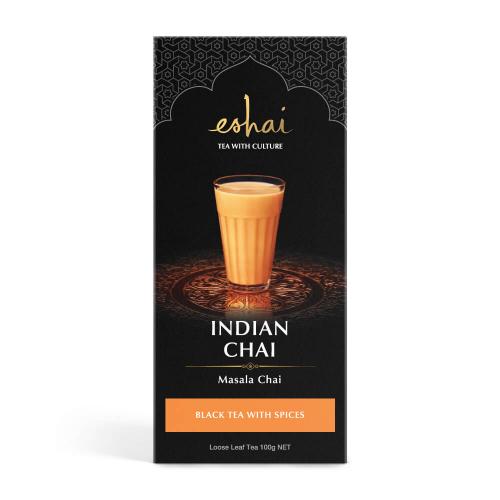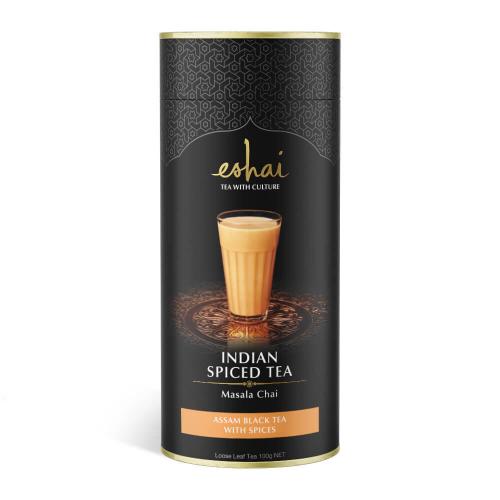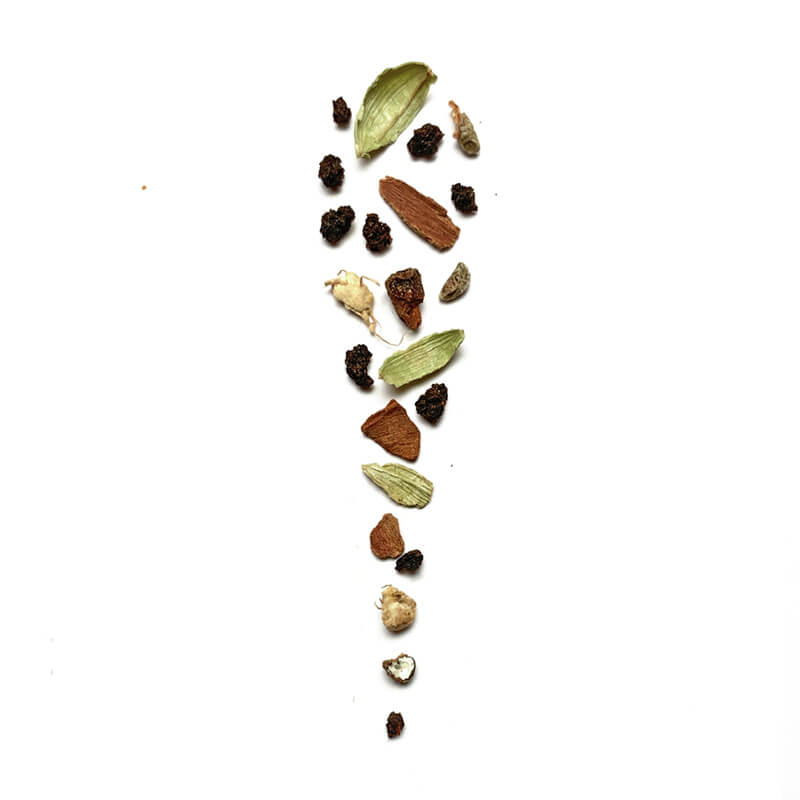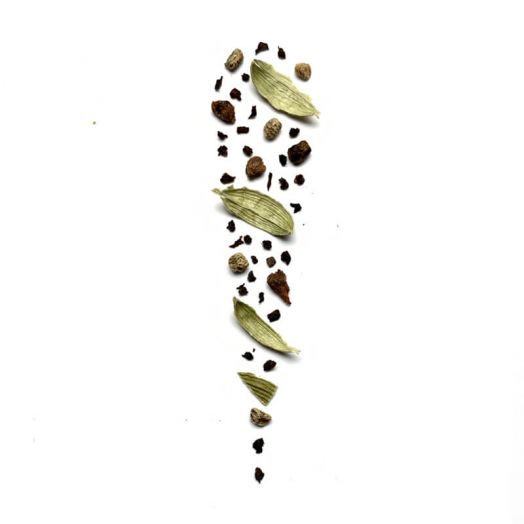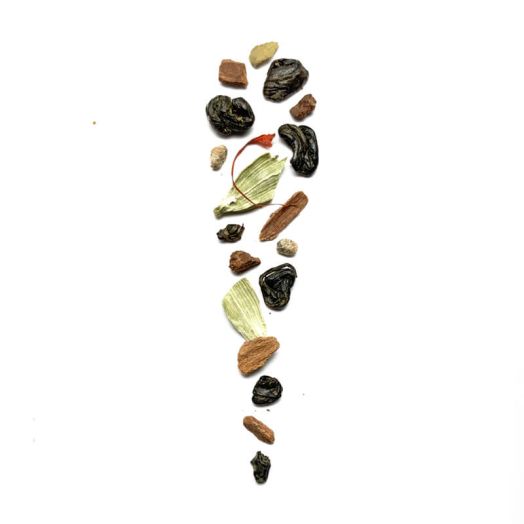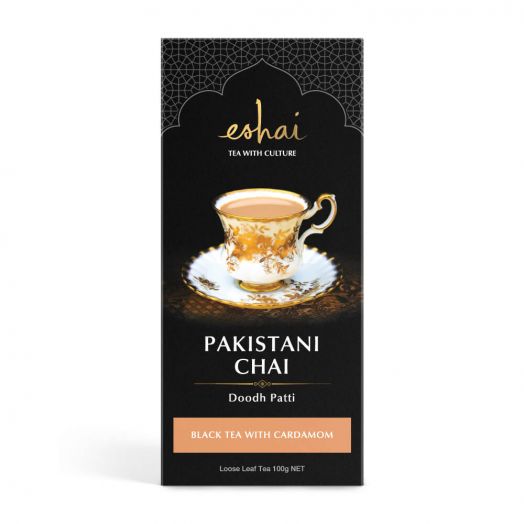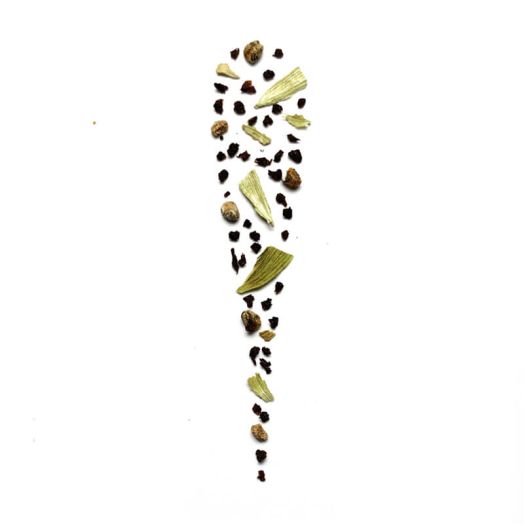What’s In The Packet?
vegan. gluten free. 100% natural. organic ingredients.
no preservatives or additives. artisanal.
hand-milled. hand-blended. hand-packaged
Feel
Soothed.
Invigorated.
Replenished.
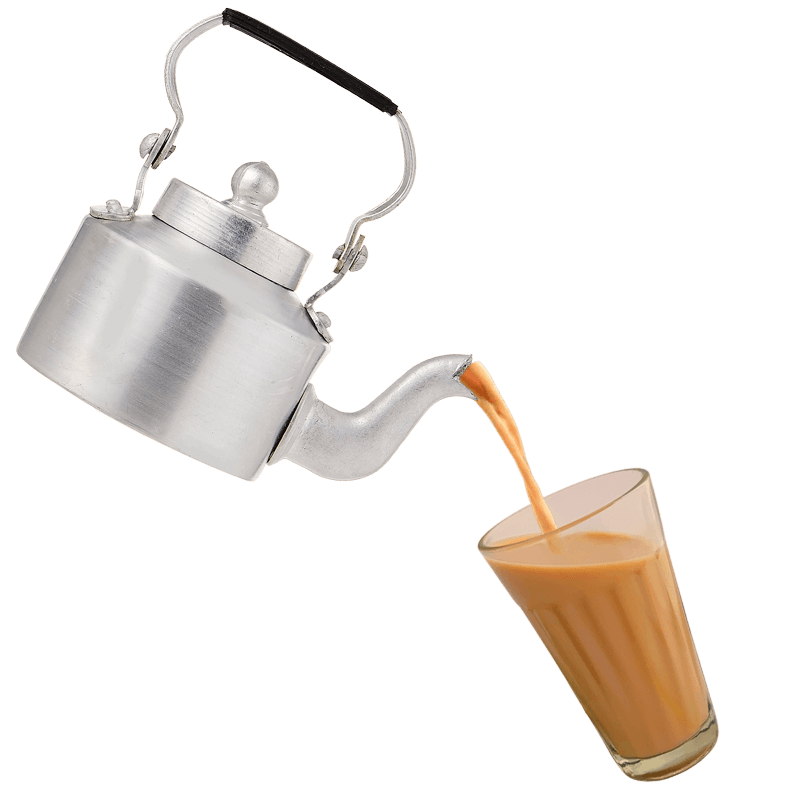
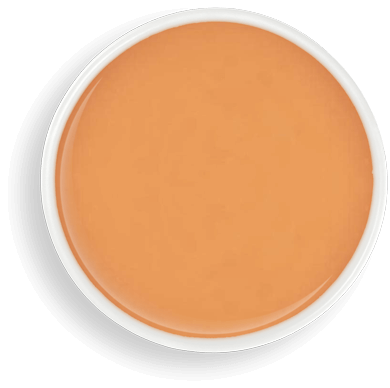
Tastes
Silky.
Spiced.
Robust.
Silky smooth and milky with harmoniously balanced spiced notes floating on a robust, malty tea base.
Experience It
Morning, Noon & Early Afternoon.
Hot or Iced. Milky & Sweet.
Solo or With Your Fav Treat.
Best Enjoyed
Straight from the stovetop, for a traditional Masala Chai experience. Put a fresh twist on the spiced goodness of Indian Chai by serving it over ice on hot days. If you’re a purist at heart, you can enjoy your chai in its natural state. However, for a truly traditional treat, add your preferred milk and then either jaggery, sugar, or your favourite alternative sweetener to the brew. This delectable combination creates a silky-smooth experience that lifts the flavour of the spices to new heights.
Best Served
Street chai is traditionally served in glass chutes, and if you’re in the north or east, clay cups. The latter are usually broken and refired each day, which probably isn’t practical in your home! Thankfully, you can impress guests in the traditional Indian way by serving chai to family and friends in your finest china or favourite teacups. In winter, Masala Chai’s warming energy can be made even cosier by serving it in that one special mug you love most.
Pairs With
While chai is a treat on its own, it pairs wonderfully with the famous street foods of India. Look for spiced crispy snack mixes like Bombay mix and masal bhel (puffed rice mix) in your local Indian grocer. Home-made favourites include deep-fried samosas and pakora. Chai is rarely enjoyed with sweets in India, but the nation is famous for delights such as fudge-like burfee, sugar-soaked deep-fried dough spirals, jalebi, and gulab jamun (sugar-soaked, fried dough-balls), all of which are a heavenly accompaniment for tea. If you can’t find any of these traditional treats, Masala Chai is divine with Parley-G bikkies (which you may find in your local Indian grocer) or your favourite tea time snack.
Tea Time
Masala Chai sets the rhythm of life in India. No matter the time or season, chai wallahs are always ready to share the magic of tea with you. While the locals enjoy chai all day through, evenings are only for those who love a late-night buzz.
Caffeine Level
High
For a shot of vitality
Taste Strength
Strong
For a punch of lively flavour
Known For
Energy Renewal. Digestion. Immunity
Brewing Guide
Brew It the Simple Way
-
Leaf
1 – 2 tsp
-
Liquid
125 ml water
125 ml milk -
Method
Stovetop brew
-
Temp
Rolling boil
-
Time
2 – 3 min
To Make 1 Cup:
- Add ½ cup (125 ml) of water and ½ cup of milk to a saucepan.
- Add 1 – 2 tsp of tea. Bring to a rolling boil.
- Reduce heat and gently simmer uncovered for 2 – 3 min.
- Stir occasionally.
- Strain into cup.
- Enjoy pure or sweeten to taste.
This Brewing Guide details how we recommend brewing your chai. But taste is a very personal thing, and we all have our own quirks and preferences. So feel free to experiment and have fun finding your tea brewing groove! You can then refer back to this Brewing Guide anytime you want a refresher on the best tools to use, the ideal brewing method, the magic leaf-to-liquid ratio, and the perfect water temperature and brewing time.
Brew It the Traditional Indian Way
Summon the full spectrum of flavours by brewing your Indian Chai the traditional way.
-
Leaf
1 – 2 tsp
-
Liquid
125 ml water
125 ml milk -
Method
Stovetop brew
-
Temp
Rolling boil
-
Time
≈ 5 min
Tea Tools
All the specialised utensils you’ll need for the traditional brew:
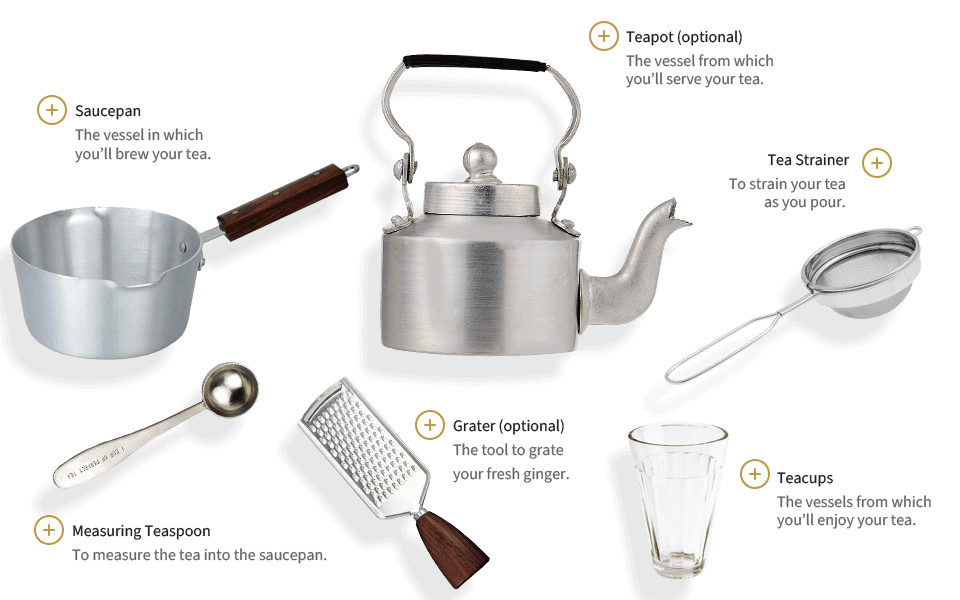
-
Measure
Depending on how strong you like your brew, you will need 1 – 2 tsp of tea per cup (250 ml) of chai. For best results, use freshly drawn ambient filtered water.
Traditional Indian Chai (Masala Chai) is brewed in milk and water. You’re free to use any dairy or plant-based milk that works for you. The most common traditional ratio for water to milk is 1:1, so if you’re making 1 cup of chai, you will need ½ cup of water and ½ cup milk. You’ll also need 1 extra tbsp of water per cup to account for evaporation. If you prefer a creamier chai, adjust by using more milk and less water.
-
Brew
Bring the water to a rolling boil in your saucepan. Next, add the tea. If you’d like your brew to have an extra ginger kick, add ½ – 1 tsp of grated fresh ginger per cup. Note: the more ginger you add, the more spiced the tea will taste, resulting in that warm tingle ginger lovers seek!
If sweetening with sugar, add it at this point and allow it to simmer with the tea to create greater depths of flavour. Reduce the heat and gently simmer uncovered for 1 – 2 min or until the tea starts to boil and the aroma of the spices fills the air.
Next, add the milk and allow the brew to again reach a rolling boil. Simmer gently on low heat until the tea starts to bubble and rise. Stir occasionally to prevent the tea from sticking to the bottom of the saucepan and burning. Once the tea starts to rise, give a quick stir to stop it from overflowing and continue simmering for another 1 – 2 min. By this point, the tea should develop a creamy brown colour. Tip: these final minutes after the brew rises are crucial as this is when most of the delectable chai flavours are released.
-
Serve
Whether you’re enjoying tea alone or with friends, you can pour directly into the teacups or transfer the brew to a teapot first. Either way, it’s best to strain it through a mesh strainer to prevent the tea leaves from flowing out. Using the back of a spoon, squeeze the tea leaves in the strainer to extract as much tea as possible. If sweetening with honey or any sweetener other than sugar, now is the time to add the desired amount.
-
Drink
If you are drinking from a traditional handle-less cup, hold the rim with your thumb and index finger. Not only is this the traditional way, but it is also the best method for ensuring you do not burn your fingers.
Before taking your first sip, savour the aroma of the tea in the teacup to experience greater depths of flavour. The brew may be piping hot, so make your first sip small and take it slow, testing the temperature of the brew so that you don’t burn yourself. If you’re not in a rush, you can also let your brew cool for a while as you savour its comforting aroma, building up anticipation for that first satisfying sip.
This Brewing Guide details how we recommend brewing your chai. But taste is a very personal thing, and we all have our own quirks and preferences. So feel free to experiment and have fun finding your tea brewing groove! You can then refer back to this Brewing Guide anytime you want a refresher on the best tools to use, the ideal brewing method, the magic leaf-to-water ratio, and the perfect water temperature and brewing time.
Brew It the Chilled-Out Way
To enjoy this tea iced, simply follow the Quick Brew steps, adjusting the leaf-to-liquid ratio based on the volume of your cup. After straining the tea into your cup, cool uncovered until it reaches room temperature. Serve chilled over ice.
Want to make a big batch to fill a glass jug or pitcher? In this case, it'll be easier to prepare a tea concentrate first. Follow the Quick Brew steps, adding the amount of leaf you'll need for the total volume of your jug or pitcher. But only add the water required for that amount of leaf to your saucepan. Don't add the milk yet. After straining the tea concentrate into your vessel, top it up with the required milk volume. No need to cool your tea – the cold milk will naturally do the job for you! Serve chilled over ice.
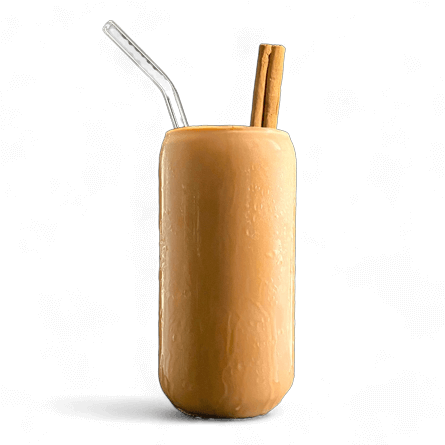
Tips
For an extra zing, add ½ – 1 tsp of grated fresh ginger per cup to the saucepan before brewing.
If you wish to make the tea sweet, it’s best to add your desired sweetener after straining but while the brew is still hot. This ensures it’s able to fully dissolve and beautifully sweeten your tea.
As the ice melts, it may dilute your tea, so consider brewing it a little stronger to get the taste you love. To do this with precision, try doubling the leaf quantity provided under Quick Brew. Experiment from there to get it to your sweet spot.
This Brewing Guide details how we recommend brewing your chai. But taste is a very personal thing, and we all have our own quirks and preferences. So feel free to experiment and have fun finding your tea brewing groove! You can then refer back to this Brewing Guide anytime you want a refresher on the best tools to use, the ideal brewing method, the magic leaf-to-liquid ratio, and the perfect water temperature and brewing time.


